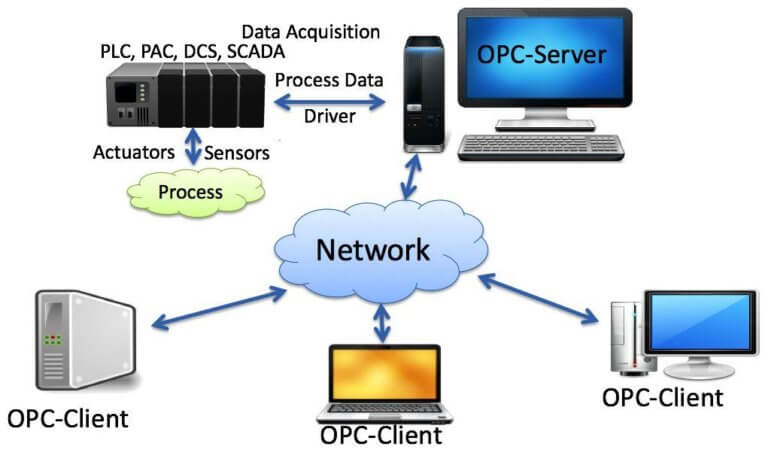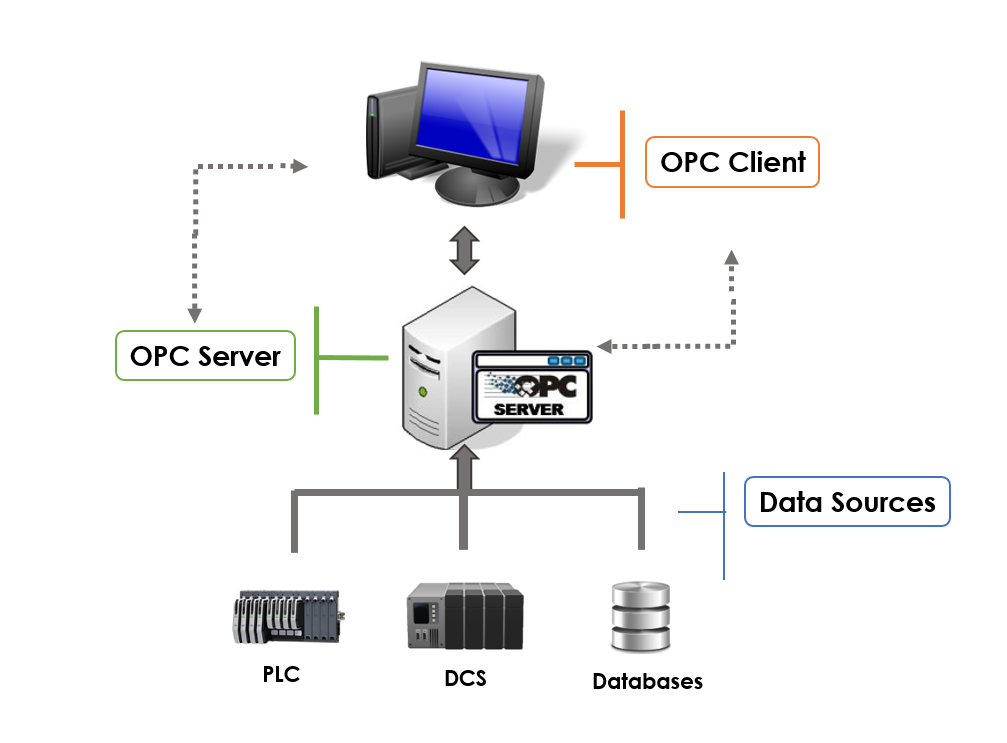OPC servers are the backbone of modern industrial automation, facilitating seamless communication and data exchange between diverse devices and systems. They serve as the bridge between the physical world of sensors, controllers, and actuators and the digital world of data analysis, visualization, and control.
The history of OPC technology dates back to the early 1990s, driven by the need for a standardized way to access data from industrial equipment. Over the years, OPC has evolved from its initial incarnation, OPC DA, to the more robust and feature-rich OPC UA, which is becoming the industry standard for industrial communication.
Introduction to OPC Servers

OPC servers are a critical component of industrial automation systems, facilitating seamless communication between different devices and applications. They act as a bridge between disparate systems, enabling data exchange and control across various platforms.
History and Evolution of OPC Technology
The OPC (OLE for Process Control) technology originated in the 1990s as a standardized way for industrial automation devices to communicate with each other. The initial version, OPC DA (Data Access), focused on providing access to real-time process data. Over time, OPC evolved to address new needs and challenges in industrial automation, leading to the development of several other specifications, including OPC AE (Alarms and Events), OPC DX (Data Exchange), and OPC HDA (Historical Data Access).
Types of OPC Servers
The different types of OPC servers cater to specific needs and applications in industrial automation.
- OPC DA (Data Access): This is the most common type of OPC server, providing read and write access to real-time process data from devices like PLCs, sensors, and actuators. It enables applications to monitor and control industrial processes in real-time.
- OPC UA (Unified Architecture): Introduced in 2008, OPC UA aims to address the limitations of previous OPC specifications by offering a more robust, secure, and platform-independent architecture. It supports various data types, including complex data structures, and provides features like security, authentication, and information modeling.
- OPC AE (Alarms and Events): This specification focuses on handling alarms and events generated by industrial devices. It allows applications to receive notifications about critical events and take appropriate actions.
- OPC DX (Data Exchange): This specification provides a framework for exchanging data between different applications and devices. It supports data transfer formats like XML and CSV, enabling interoperability between systems.
- OPC HDA (Historical Data Access): This specification provides access to historical data stored by industrial devices. It allows applications to analyze trends, identify patterns, and make informed decisions based on past data.
OPC Server Architecture and Functionality

OPC servers play a crucial role in industrial automation by providing a standardized way to access and exchange data from various devices and systems. They act as a bridge between different protocols and technologies, enabling seamless communication and data integration within a manufacturing environment.
OPC Server Architecture
An OPC server’s architecture is designed to handle the complexities of data acquisition, processing, and distribution. It consists of several key components that work together to fulfill its functionalities:
- Data Source Interface: This component is responsible for connecting to and retrieving data from the underlying devices or systems. It acts as the bridge between the OPC server and the physical world. Examples include drivers for specific PLCs, databases, or other industrial equipment.
- Data Model: This component defines the structure and organization of the data received from the data source. It translates the raw data into a standardized format that can be understood by the OPC client applications. The data model typically uses OPC Data Access (OPC DA) or OPC Unified Architecture (OPC UA) specifications.
- Data Cache: This component stores a local copy of the data received from the data source. This cache improves performance by reducing the need for frequent communication with the data source. It also allows for data aggregation and historical data logging.
- OPC Server Engine: This component manages the overall operation of the OPC server. It handles communication with OPC clients, manages data subscriptions, and enforces security policies.
- Communication Interface: This component handles communication with OPC clients using protocols like DCOM or TCP/IP. It ensures that data is transmitted securely and reliably between the OPC server and clients.
OPC Server Functionalities
OPC servers offer a range of functionalities that enable them to serve as a central hub for industrial data management:
- Data Access: OPC servers provide a standardized way to access data from different devices and systems. They allow clients to read and write data values, browse data structures, and subscribe to data changes. This functionality is essential for real-time monitoring and control applications.
- Data Aggregation: OPC servers can aggregate data from multiple sources into a single view. This simplifies data analysis and allows for a more comprehensive understanding of the industrial process. For example, an OPC server can collect data from different PLCs and combine it into a single report for overall process performance analysis.
- Data Logging: OPC servers can store historical data for analysis and troubleshooting. This data can be used to identify trends, diagnose problems, and improve process efficiency. Historical data logging is crucial for optimizing operations and ensuring compliance with regulations.
Connecting Devices and Systems
OPC servers play a vital role in connecting different devices and systems within an industrial environment. They bridge the gap between various protocols and technologies, enabling seamless communication and data integration. This is achieved through:
- Protocol Conversion: OPC servers can translate data between different protocols used by various devices and systems. For example, an OPC server can connect to a PLC using a proprietary protocol and provide access to the data using the OPC DA or OPC UA standard.
- Data Consolidation: OPC servers can collect data from multiple devices and systems and present it in a unified format. This simplifies data access for clients and allows for a holistic view of the industrial process. For instance, an OPC server can collect data from sensors, PLCs, and databases and provide a single view of the entire production line.
- Interoperability: OPC servers promote interoperability between different devices and systems, regardless of their manufacturer or underlying technology. This allows for the integration of various components into a single automation system, improving flexibility and scalability.
OPC Server Communication Protocols
OPC servers utilize various communication protocols to exchange data with clients. These protocols determine how data is transmitted between the server and client applications. This section will explore the common protocols used by OPC servers, their characteristics, and their advantages and disadvantages.
DCOM
DCOM (Distributed Component Object Model) is a Microsoft technology that allows objects to communicate across different machines and networks. In the context of OPC servers, DCOM enables clients to access and control OPC server objects remotely.
- Advantages:
- DCOM is a mature and widely used technology, offering robust security features.
- It provides a high level of integration with Windows operating systems.
- DCOM offers a relatively simple programming model for accessing OPC servers.
- Disadvantages:
- DCOM is primarily designed for Microsoft Windows environments, limiting its cross-platform compatibility.
- DCOM can be complex to configure and troubleshoot, especially in large and complex systems.
- DCOM’s security features can be challenging to implement and maintain, potentially increasing the risk of security vulnerabilities.
TCP/IP
TCP/IP (Transmission Control Protocol/Internet Protocol) is a widely used suite of protocols for communication over the internet. OPC servers can leverage TCP/IP to establish connections with clients and exchange data over a network.
- Advantages:
- TCP/IP is a highly versatile and reliable protocol, supporting various applications and network environments.
- It offers excellent cross-platform compatibility, allowing communication between different operating systems and devices.
- TCP/IP provides a robust framework for data transmission, ensuring reliable and secure data delivery.
- Disadvantages:
- TCP/IP can be relatively complex to implement, requiring knowledge of networking concepts and protocols.
- TCP/IP’s overhead can impact performance, especially in high-bandwidth applications.
- While TCP/IP provides reliable data delivery, it can be susceptible to network congestion and latency issues.
UDP
UDP (User Datagram Protocol) is a connectionless protocol that offers a lightweight and efficient way to transmit data over a network. OPC servers can utilize UDP for faster data exchange, particularly for applications that require low latency and minimal overhead.
- Advantages:
- UDP is a lightweight protocol, requiring minimal resources and overhead, making it suitable for high-performance applications.
- UDP’s connectionless nature enables faster data transmission, ideal for real-time applications with strict latency requirements.
- UDP is relatively simple to implement, requiring less configuration and setup compared to TCP/IP.
- Disadvantages:
- UDP does not guarantee data delivery, making it less reliable than TCP/IP.
- UDP lacks error checking mechanisms, increasing the risk of data corruption or loss.
- UDP’s connectionless nature makes it unsuitable for applications requiring reliable and ordered data transmission.
Comparison of Communication Protocols
| Protocol | Features | Use Cases |
|---|---|---|
| DCOM | Microsoft technology, robust security, high integration with Windows, simple programming model | Applications requiring tight integration with Windows systems, robust security, and simple access to OPC servers |
| TCP/IP | Versatile and reliable, cross-platform compatibility, robust data transmission framework | Applications requiring reliable and secure data exchange across different platforms and networks |
| UDP | Lightweight and efficient, connectionless, low latency | Applications requiring fast data exchange, minimal overhead, and low latency, such as real-time monitoring and control systems |
Summary
OPC servers play a pivotal role in enabling efficient and reliable operations in various industries. Their ability to connect disparate systems, standardize data access, and ensure secure data exchange is essential for optimizing processes, reducing downtime, and driving innovation. As the industrial landscape continues to evolve, OPC technology will remain at the forefront, facilitating the integration of emerging technologies like cloud computing and the Internet of Things (IoT) into industrial automation.
OPC servers are essential for industrial automation, providing a standardized way to access and exchange data. When you’re not busy monitoring process variables, consider adding a personal touch to your space with some diy bedroom ideas , just like you might configure your OPC server to optimize data flow.
After all, a well-organized and visually appealing bedroom can help you relax and recharge, just as a well-managed OPC server ensures smooth and efficient industrial operations.
